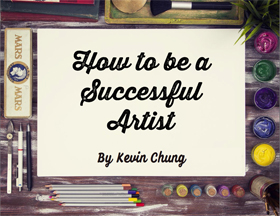So you’ve decided to create a website for your art. If you still need convincing, read “Should I build a website for my art?” Yes, and I’ll Tell You Why. You might be asking yourself “What the heck am I supposed to put on it?” or “Where do I even begin?”
Before you get started, check out The Abundant Artist’s Website Checklist. It gives you a good idea of what you need to know before you can build your website. A few of the major points are: making sure you do your competitor research, deciding on your brand and what makes you unique as an artist, and deciding on a webhost/publishing platform. Doing these things beforehand will save you a lot of time and pain in the future. Once you are ready to begin make sure you follow these do’s and don’ts of an artist website:
The Do’s of an Artist Website:

Photo by raulurzua
Your site should have a responsive design
Having a website that is viewable on multiple screens and devices is more important than ever. You have probably noticed this trend yourself. How often do you browse websites on your phone or tablet? The number of people browsing the internet on their phones and tablets has been increasing every month since the iPhone came out.
Your site should work on all the major web browsers
Have you ever left a website because it looked broken when you visited it? Your visitors will leave too. You don’t want people to leave your site because your site didn’t look right in their browser.
Your site should load quickly
People on the internet have an extremely short attention span. According to a study from 2009, 47% of people expect a website to load in two seconds or less, and 40% will abandon a web page if it takes more than three seconds to load. If your site doesn’t load quickly people will leave in a heartbeat.
Your site should be easy to navigate
Do you you leave a website when you can’t find what you’re looking for? Your visitors will too. If people come to your site and have trouble finding their way around, they are going to leave without hesitation. Make sure all your important information is easy to find. Make sure you aren’t making these website navigation mistakes.
Your site should be easy to use
Make sure it’s easy for anyone to understand and only provide information people need. Even beautiful sites can be hard to use. Don’t create anything that will drive people away.
Your site should have an image gallery and prices
One common mistake artists make when building a website is not having prices for their artwork, or ways for viewers to buy their work. How can someone buy your art if you don’t have a price or ways to buy it? If you need help, here’s an article for pricing your art.
Your site should have attractive, professional looking photos
Whether you pay someone to take pictures of your work or take them yourself, they should be high quality and attractive. Unless someone sees your art in person, the only impression they get of your work is from the photos you show them. Photographing techniques for canvas paintings are different from items you are selling on Etsy. Make sure you know which technique to use.
You should have a URL related to your name or brand
You want to make it easy for people to find you on the internet. The easiest way to do this is to use your name or brand as the URL. If you are having trouble figuring out what your URL should be, check out this guide for coming up with a domain name.
You should sell art at multiple price points
You don’t want to discourage people who are interested in your art from buying it. You can do this by having prints and smaller pieces to sell along side your larger more intricate works.
You should cater your site to your audience
If you are trying to reach a certain audience with your work, make sure you convey that on your site. It will be much easier to convince them to buy your work if they think you are talking directly to them.
You should provide examples of what your work will look like in context
If you are selling large canvas art, show it in a bedroom or living room. If you are selling jewelry, show somewhere wearing it. This way your audience can imagine it within their own lives.
You should blog and talk about yourself
Nothing keeps your current customers interested in your work more than stories you can tell about yourself. When they have someone to relate to, they are much more likely to buy more of your art. Create a blog for your site, and let people see what goes on what you create your work. Not convinced, read the reasons you should blog about your art.
You should have information on how a sale works
Talk about how someone can view your work, what payment methods you accept, how the art will be packed, how it will be shipped, and any other information a prospective buyer will want to know. The more clear and precise the information you provide, the more professional you will appear.
You should link to any social media accounts you have
The more ways you provide customers to interact with you the better. You want to be easily accessible to anyone that wants to talk with you so you can build strong relationships with them.
The Don’ts of an Artist Website:

Picture from Wikimedia
Having a website that is difficult to update
One thing that will ensure you don’t post new stuff to your website is by making it difficult to update. You should be able to easily update your site whenever you need to.
Paying someone to update your site
Along the same lines, you shouldn’t be paying someone to make updates to your site. Your site should be built on a platform that allows you to make updates yourself.
Creating a site that is difficult to use
A few things you should avoid when creating your site are having a complicated layout/navigation, having links that blend in with text, having cluttered pages, and making your site hard to read by not contrasting your text or using a lot of different fonts and text sizes. Just follow these principles of effective web design.
Creating your site using Flash
Flash may have been a great website building tool years ago, but that is no longer the case. Flash sites are not indexed on Google and they don’t work on most mobile phones/tablets.
Installing a plugins/add-ons without knowing what they do
Unless you know exactly what a plugin or add-on will do for your site, don’t install it. You risk having security issues or bugs that can slow down your site.
Showing every single piece of art you’ve created
People aren’t on your website to see everything you’ve ever created. You should be selective about what work you show. Pick pieces that are a good representation of your work.
Show previously sold work along with unsold work
People may see pieces that haven’t been sold as leftovers if you surround them with too many sold pieces. Instead, try creating a separate page on your site that shows only pieces that you’ve sold.
Make information difficult to find
Nothing is more frustrating to a visitor than not finding what they are looking for. Make sure your most important links are easy to find and get back to. Also, make sure you don’t use any ambiguous or technical terms. Use words that everyone can understand.
You don’t update your site
Your website should be updated whenever you have a new piece or something new to say. Don’t let it just sit there. People won’t go back to a website that is never updated or they might assume you don’t make art anymore.
Bonus -Pages you should include on your website:

Picture by OpenClips
Contact Information
One critical thing many artists neglect to add to their sites are ways for interested buyers to contact them. You should list your phone number and e-mail, or at the very list a contact form for people to fill out. Nothing prevents a sale or interested gallery than a lack of contact information.
Blog and Newsletter
One of the most important things you can have on your website are a blog and newsletter. This combination is one of the most undervalued and underused tools an artist possesses. Your blog should have news, updates about your work, and your thoughts about your work. Your newsletter is the easiest way for you to keep in touch with your customers. This combination makes for the strongest bond between you and your audience.
About Page
Your about page should relate to the viewers of your website before you talk about yourself. If you’ve done your job right, they will want to know more about you. You should include reasons they should buy from you and what makes your art unique without trying to sound sales-y.
Artist statement
Your artist statement should explain your work in a short, easy to understand, and bold statement. Make sure it is memorable and describes your work without writing a novel.
Exhibitions
If you want people to see your work up close, you need to provide a list of exhibitions and places your art will be shown.
Press
Nothing adds more credibility to an artist than press they’ve received. If someone sees you were featured in something like The Huffington Post, New York Times, or other major media publications, they will automatically become more interested. Celebrate your wins!
Refund Policy
A refund policy will show confidence in your own work and add credibility to your site. If people don’t see a refund policy, they may assume that you aren’t willing to deal with complaints.
Testimonials
Another thing many artists forget to add to their site are testimonials from happy customers. Unlike commercial products, many customer testimonials for art will can tell a story, and they will often be filled with emotion. Both of which help sell your art.
Conclusion
This may be a lot of information to digest, but many of these things will help make or break your website. The biggest keys are making sure your site is easy to use, making sure people can find what they are looking for, making sure you communicate clearly and personally with your customers, and making sure your customers and potential customers have an easy way to stay in touch with you. If you want additional resources on building your blog or website, here’s a nice resource.
As always, if you know of any artists that are making these mistakes, share this article with them.
To get a checklist of all the do’s and don’ts of an artist website, subscribe to my free marketing tips below. Future articles will include blogging, creating newsletters, tools for tracking your user interactions, what makes a good post, article headlines, site designs that work, and much more. I also plan to explore social media and SEO for those who are ready. Is there anything missing from the list or you wholeheartedly agree or disagree with? Leave it in the comments.







July 9, 2014 at 3:30 pm
Hi Kevin, thanks for your instructions!
Best regards,
Matej
August 22, 2014 at 3:19 am
Hi Kevin, just found your site, everything looks awesome! And I agree about pricing your art; it’s tricky if you do mainly gallery work but for selling direct, need to price.
August 22, 2014 at 6:08 am
Hey Derek, thanks for stopping by!